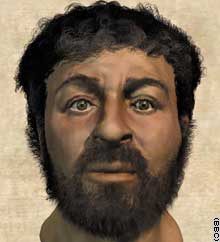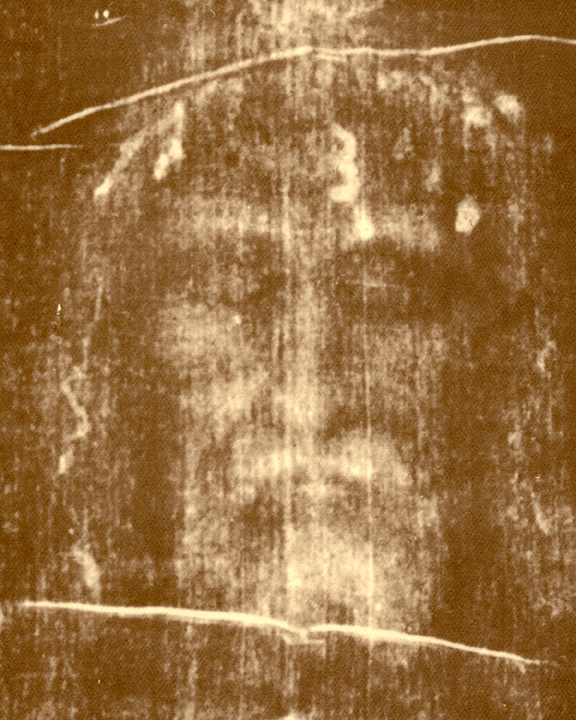The “scientist” Richard Neave further reveals what he’s really about
(Note, 11:40 p.m. May 7: a bunch of comments have been added to this entry.)
There are people who insist, against all the evidence, that British forensic artist Richard Neave’s “reconstruction” of the face of the “first European” as an African black was a product of objective science, arrived at entirely independently of the all-pervasive liberal assumptions and biases that inform our culture. That naive view of Neave is further discredited by his computer simulation of what Jesus “really” looked like:

It’s the face of a rather unimpressive, even low individual, a face with almost no forehead, a face that suggests below average intelligence, perhaps even criminal tendencies, a face without an ounce of nobility or spiritualty, a face that reflects not the slightest hint of outstanding qualities or talents. And Neave presents it as a likely likeness of Jesus. And, further, because of Neave’s aura of scientific expertise (and once our culture has thrown out its entire tradition, what authority is left but scientific expertise?), many people will sneeringly or indignantly deny the suggestion that there was any liberal or anti-Christian bias at work in Neave’s “recreation” of Jesus. They will say that Neave was working purely as a scientist and that it is slander to suggest otherwise.
In our liberal culture, to say that Jesus Christ was a sub-par human being is perfectly fine; to say that Richard Neave is a liberal is an outrage.
- end of initial entry -
Joel P. writes:
Not to defend Neave’s computer simulation of what Jesus “really” looked like, but the fact that there is nothing impressive about his appearance is, at least, consistent with Scripture.
Isaiah 53:
Who has believed what he has heard from us?
And to whom has the arm of the LORD been revealed?
For he grew up before him like a young plant,
and like a root out of dry ground;
he had no form or majesty that we should look at him,
and no beauty that we should desire him.
He was despised and rejected by men;
a man of sorrows, and acquainted with grief;
and as one from whom men hide their faces
he was despised, and we esteemed him not.
However, that point made, I do agree with your larger point. And I do agree with you that Neave’s “portrait” makes Christ look like a rather unintelligent person, without a hint of spirituality. One can certainly lack majesty and beauty in his appearance and yet still have an aura of intelligence about him. Neave’s Jesus not only looks like a man who would have trouble finding his way out of a paper bag, but he also lacks even a modicum of the spiritual presence needed to cause men to hide their faces in shame.
But there’s no bias here. Nope. This is strictly “science.”
LA replies:
Clever point re Isaiah 53. Touche. But of course Isaiah 53 is not a photographic description of Jesus. It is expressing a spiritual idea, which Jesus in various ways, subtle and obvious (the crucifixion), embodied.
Rick Darby writes:
According to the description of Neave’s methodology on the “Religious Tolerance” web site where the Jesus reconstruction is posted, this is one more example of extrapolating scant evidence into what someone already assumes.
Science is pretty good at deriving knowledge, at least of a materialistic sort, from actual present objects. When dealing with remains of what once was, its conclusions are much less reliable. Every biblical archeologist, for example, is the one true expert, with all the rest maddeningly obtuse.
Neave’s reconstruction is even farther removed from any solid evidence. People with a fuzzy grasp of the scientific method don’t understand what’s wrong when scientific “facts” are based on a series of assumptions.
Neame’s portrait is based on the following assumptions, none of which qualifies as proven, or even necessarily likely: 1. “Jesus resembled a typical peasant from 1st century CE Palestine.” (Who knows how much difference there was in appearances? Palestine was at a crossroads of civilization, with Romans, Phoenicians, Arabs, Egyptians, and many other types likely to have been well represented). [LA replies: Jesus resembled a peasant? He was a rabbi.]
2. Neame and colleagues “started with an Israeli skull dating back to the 1st century.” (Possibly it could be dated with such accuracy, although archeological dating is not the most exact science. And how does anyone know that it was the skull of an “Israeli,” and not a trader or traveler from somewhere else? Then, as now, there was no law against dying wherever you happened to find yourself.)
3. “They then used computer programs, clay, simulated skin and their knowledge about the Jewish people of the time to determine the shape of the face, and color of eyes and skin.” (Jewish people of the time: What if he was a Roman soldier? Computer programs: garbage in, garbage out. Clay: How does using clay “determine” anything except what the modeler thinks it should look like? Color of eyes and skin: I will, upon request, send Neame a CAT scan of my skull, and ask him to determine my eye color if he will agree to forfeit $1,000 if he is wrong. I suppose he could determine that I am of the white race, but I would also challenge him to produce a color swatch that would match my skin to an artist’s satisfaction.)
4. ” … a person with abroad peasant’s face, dark olive skin, short curly hair and a prominent nose.” (Skulls do not have hair or noses.)
5. “They guessed at the length of Jesus’ hair on the basis of the reference by Paul that “If a man has long hair, it is a disgrace to him.” They speculate that Paul would not have written this if Jesus Christ had had long hair?” (As an aside, this writer, so-called, apparently thinks that “they speculate” means the sentence is a question and should be so punctuated. I have no idea what Paul meant, but he might have held Jesus to a different standard than men who let their hair grow long because they were too lazy to get it cut.)
Another interesting thing about the “Religious Tolerance” article: the photo of the actor Jim Caviezel actually looks more like the image on the shroud of Turin, who is long-haired, than the “typical” picture in the center with a “long Presbyterian nose.” Yep, you can spot a Presbyterian across the room.
Steve D. writes:
I’m surprised that no one has yet pointed out this little delicacy from the linked story:
” … started with an Israeli skull dating back to the 1st century … ”
Trying to reproduce the features of a particular person by using a random skull—especially when you have no idea what your target actually looked like—isn’t even rational, let alone scientific. It is worse than trying to reproduce Lawrence Auster’s features by starting with the skull of a random New Yorker … at least they know, in your case, what the end result should be. But this is so phony that it immediately announces an agenda at work.
Another curious facet: if you were to use the phrase “typical Jew” in almost any other context, you would immediately be suspected of anti-Semitism at worst, and poor social skills at best. But when the purpose of the enterprise is to render unremarkable the man whom millions of people revere as the Son of God, “typical Jew” becomes the target. Why were there no howls of (manufactured) outrage over this? [LA replies: Yes. And the “typical Jew” turns out to be a low, unintelligent, base-looking individual, his face marked with every vice. Yep, that’s the typical Jew, all right. By the way, for a wonderful recreation of what first century Jews may have looked like, see the Claymation movie, “The Miracle Maker,” about Jesus. It’s sadly not well known, but I think it’s the best Jesus movie ever made. It is not just for children. Because the movie makers created the characters as they wanted them to be, rather than being dependent on actors, they were able to create believable Jewish types.]
Ian B. writes:
Well, regardless of whether or not Neave was specifically trying to make Jesus look like a slack-jawed schmoe with a blank look on his face, one thing is for sure: Neave had precisely zero bone fragments at hand when constructing this “simulation.” This rendering is clearly 100 percent imagination on the part of Neave, and could be any Middle Easterner. This is nothing that couldn’t be done by any individual sitting at home with a 3D modeler and some knowledge of how to use it.
What this “simulation” does provide us, however, is a clue as to how much credibility should be placed on other “simulations” by Richard Neave, such as his Cro-Magnon “simulation.” Hopefully, even Richard T. isn’t so daft as to claim that Neave’s scientific training gives him super-secret psychic powers to know what Jesus looked like. I swear, some people completely turn off the critical thinking portions of their brains the moment someone flashes a degree and breaks out the word “science.”
What Richard T. has demonstrated is that a scientist could essentially lie to him indefinitely, about anything, and he would never, ever catch on, no matter how implausible the lies, but would just passively absorb it all forever.
LA replies:
“a slack-jawed schmoe with a blank look on his face”
Much better than my wordy description.
You know what this “Jesus” looks like? A close-up, Near Eastern version of The Man with the Hoe.
This is from Edward Markham’s poem, “The Man with the Hoe,” inspired by Jean-Francois Millet’s painting, L’homme a la houe:

Who loosened and let down this brutal jaw?
Whose was the hand that slanted back this brow?
Whose breath blew out the light within this brain?
Is this the Thing the Lord God made and gave
To have dominion over sea and land;
To trace the stars and search the heavens for power;
To feel the passion of Eternity?…
What gulfs between him and the seraphim!…
Through this dread shape humanity betrayed,
Plundered, profaned, and disinherited,…
O masters, lords and rulers in all lands,
Is this the handiwork you give to God,
This monstrous thing distorted and soul-quenched?
How will you ever straighten up this shape;
Touch it again with immortality;
Give back the upward looking and the light;
Rebuild in it the music and the dream…?
Yet, according to the respected “scientist” Richard Neave, the dazed, debased, corrupted human being portrayed in Neave’s “historical recreation” and also described in Markham’s poem is none other than Jesus Christ.
Also, in fairness to Richard T., he told me, “I’ll take your comment about false consciousness under advisement… I’m going to wait and see if more information becomes available, particularly in regards to the provenance of the skull, before I comment further.”
Joe Catechissimo writes:
You guys at VFR ever hear of an honest mistake? This allegedly Afrocentric forensic expert simply mixed up his samples. His depiction of Jesus is really that of “The First European,” and his “First European” is a Detroit murder victim. Father Auster, forgive him, for he knows not what he does.
LA replies:
That’s really funny.
Lucy Z. writes:
I have been following your blog for a while now and have to thank you for bringing up ideas that I probably would not have considered otherwise.
As to the subject matter, I’m quite convinced that Jesus was unattractive simply because people are almost mesmerised by the very physically attractive.
Put this way, Jesus’ appeal was to be of a spiritual nature, not of the flesh. Isaiah 53 refers to this.
In direct contrast, the Antichrist is described as being “the desire of women.” In other words, he will be a highly attractive individual and able to gain a large following based in some part on his looks (Dan 11:37). There are other opinions on that text, however, including that the Antichrist will be a homosexual or that his self-love will be of such a magnitude that marrying one woman would be impossible.
Many thanks for your dedication and effort in producing your blog. I don’t always agree with you but at least you get me to think!
LA replies:
Thank you.
But Jesus did attract a very large following. He became the popular sensation of his time, doing miraculous healings, with thousands of people following him around. From this, and from the entire Gospel account, we know he had personally appealing, exceptionally commanding qualities, and was not some withdrawn, obscure figure without form or features. In any case, being “Jesus Christ, Superstar” was part of his ministry. Ultimately of course he was abandoned and rejected by everyone, more in keeping with the meaning of Isaiah 53, but that was by his own design, as part of the Passion drama of which he was the screenwriter, star, and director. I hope that doesn’t sound disrespectful, because it’s meant to be just the opposite. It means that he was the God-man and was in charge of everything that happened, including his betrayal by Judas, his abandonment by the other disciples, and his perfect sacrifice and death.
My point is that, as profound as Isaiah 53 is, we should not take it as literal description of Jesus’ physical appearance and personality. Rather, in his career as savior of the world, he enacted the meaning of Isaiah 53.
But there is a further inner meaning of Isaiah 53 in relation to Jesus. Whatever his external appeal and prominence, the real Person of Jesus remains generally obscure and unseen. During his earthly life, and even now, he is ignored and despised, suffering from our continual turning away from him, even as he continues to offer himself for our guidance and salvation. So Isaiah 53 is continually true.
The same is expressed in John 1: “He was in the world, and the world was made through him, and the world knew him not.”
At the same time, even as men are constantly turning away from him, Jesus remains always accessible to us. That is why he came into the world, to make God manifest and accessible to man.
John B. writes:
Adam (scientific reconstruction):

LA replies:
That is very clever, and very apropos of this discussion.
Paul V. writes:
There are many reasons, including the results of an exhaustive scientific study, to believe the Shroud of Turin is the true likeness of Jesus. I don’t know any reasons to the contrary, the carbon 14 dating purportedly showing it to be a 13th century forgery having been withdrawn under a cloud.
The face itself is truly an image worthy of the God-Man.

May 8
Chris L. writes:
I believe Paul V.’s comment needs to be expanded a bit more because it highlights the weakness of science and scientists. The National Geographic Channel ran a show about the continuing controversy over the Shroud of Turin. I was not expecting much since I remembered that carbon dating had shown the shroud to be from the 14th century. The show went through a history of the scientists who had studied the shroud for several decades and the unique properties of the image on the shroud. It was considered a great moment when the Vatican finally allowed the study group the ability to take a sample of the shroud for carbon dating. The result of the dating was the famous 14th century result. As a result, the shroud was generally believed to be a fake.
Of course, a lot of people who believed the shroud to be real did not accept the results. Many of the counter theories were pretty nutty or conspiratorial but a few were reasonable challenges. One theory was that the sample taken was tainted with newer material. A couple in Columbus, Ohio did a lot of research and found a French technique for repairing fabric that could explain how new material could have been almost invisibly woven into the shroud to repair it. They eventually convinced one of the shroud scientists to take a look at the fabric samples again. As they had suspected, new fabric had been woven in to patch the shroud. The newer fabric threw off the carbon dating results. Certain factors make it unlikely that even if they could carbon date another sample they could get an accurate result. Some of those factors were present before the first test so I do not know why they were not considered then.
Think about this, a group of scientists with almost full access to the shroud make a mistake that is only corrected when some laymen with an internet connection figure out there is a problem. Science has a role to play in society, but the near worship of it is not healthy. As with anything humans do, science is prone to errors and bias. If scientists can mess up working with an object to which they have nearly complete access, how much greater are the chances for mistakes as the amount of information decreases and becomes more sporadic due to increased time from the event?
Posted by Lawrence Auster at May 07, 2009 02:48 PM | Send



